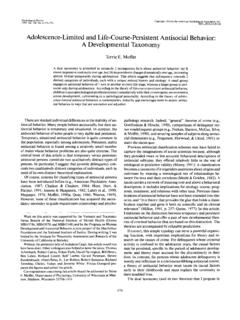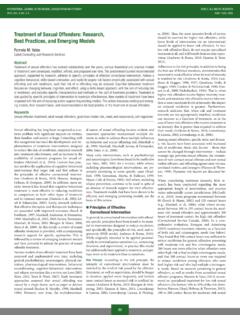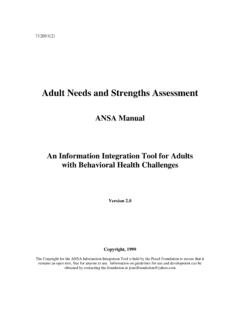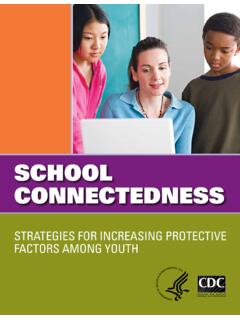Transcription of Corporal Punishment by Parents and Associated Child ...
1 Corporal Punishment by Parents and Associated Child Behaviors andExperiences: A Meta-Analytic and Theoretical ReviewElizabeth Thompson GershoffColumbia UniversityAlthough the merits of Parents using Corporal Punishment to discipline children have been argued fordecades, a thorough understanding of whether and how Corporal Punishment affects children has not beenreached. Toward this end, the author first presents the results of meta-analyses of the association betweenparental Corporal Punishment and 11 Child behaviors and experiences. Parental Corporal Punishment wasassociated with all Child constructs, including higher levels of immediate compliance and aggression andlower levels of moral internalization and mental health. The author then presents a process contextmodel to explain how parental Corporal Punishment might cause particular Child outcomes and considersalternative explanations. The article concludes by identifying 7 major remaining issues for Punishment has been an integral part of how parentsdiscipline their children throughout the history of the United States(Greven, 1991) and has been a focus of psychological research fordecades ( , Caselles & Milner, 2000; Eron, Walder, Huesmann,& Lefkowitz, 1974; Glueck & Glueck, 1950; MacKinnon, 1938; , 1988b; Sears, 1961; Straus, 1994a).
2 Although a growingnumber of countries have adopted policies or laws that prohibitparents from using Corporal Punishment as a means of discipline(Austria, Croatia, Cyprus, Denmark, Finland, Germany, Israel,Italy, Latvia, Norway, and Sweden; Bitensky, 1998; EPOCH-USA, 2000), both support for and use of Corporal punishmentremain strong in the United States, with 94% of American parentsspanking their children by the time they are 3 or 4 years old (Straus& Stewart, 1999).Psychologists and other professionals are divided on the ques-tion of whether the benefits of Corporal Punishment might out-weigh any potential hazards; some have concluded that corporalpunishment is both effective and desirable ( , Baumrind, 1996a,1996b, 1997; Larzelere, 1996, 2000), whereas others have con-cluded that Corporal Punishment is ineffective at best and harmfulat worst ( , American Academy of Pediatrics, 1998; Lytton,1997; J. McCord, 1997; Straus, 1994a).
3 This controversy overcorporal Punishment has inspired a series of recent debates amongpsychological, sociological, and legal scholars about what corporalpunishment does and does not do for children (see Donaldson,1997; Friedman & Schonberg, 1996; Mason & Gambrill, 1994;Pervin, 1997).Despite this controversy and the hundreds of scientific studiesinvoked on either side of the debate, understanding of the childbehaviors and experiences Associated with parental Corporal pun-ishment has been limited to narrative reviews ( , Becker, 1964;Straus, 1994a) and vote count summaries of the number ofpositive and negative effects that accrue from Corporal Punishment ( , Larzelere, 1996, 2000; Steinmetz, 1979). Crucial questionsremain unanswered, such as what range of Child behaviors andexperiences are empirically Associated with parental Corporal pun-ishment, as well as why, how, and for whom Corporal punishmentmight have such effects. This article provides preliminary answersto these questions by synthesizing the current empirical evidenceof, and theoretical explanations for, associations between parentalcorporal Punishment and 11 Child behaviors and experiences.
4 Inthe first half of the article, the empirical evidence linking parentalcorporal Punishment and both positive and negative Child con-structs is synthesized through meta-analyses. In the second half ofthe article, I present a process context model that identifies theprocesses in the Child that might transform the experience ofcorporal Punishment into manifest Child behaviors and that sug-gests types of children and Parents for whom and circumstancesunder which positive or negative associations might be model is intended to summarize the Child processes, contex-tual influences, and Child constructs Associated with parental cor-poral Punishment as well as to provide a guide for future researchon Corporal Punishment and its Associated Child behaviors andexperiences. In the final section of the article, I identify sevenmajor issues that need to be addressed in future research todetermine the specificity and causal direction of associations be-tween parental Corporal Punishment and Child behaviors and ex-periences.
5 Taken together, this article summarizes the empiricaldata on associations between parental Corporal Punishment andchildren s behaviors, reviews theoretical work to explain why suchEditor s Andrew Collins served as the action editor for thisarticle. NEI am indebted to Theodore Dix, George Holden, Pamela Miller, MurrayStraus, George Knight, Robert Larzelere, Diana Baumrind, and LawrenceAber for their comments on and assistance with previous versions of thisarticle. Writing of this article was supported in part by a predoctoralUniversity Continuing Fellowship from the University of Texas at Austinand a National Institute of Mental Health-sponsored postdoctoral fellow-ship through the Program for Prevention Research at Arizona concerning this article should be addressed to ElizabethThompson Gershoff, National Center for Children in Poverty, ColumbiaUniversity, Mailman School of Public Health, 154 Haven Avenue, NewYork, New York 10032.
6 E-mail: BulletinCopyright 2002 by the American Psychological Association, , Vol. 128, No. 4, 539 5790033-2909/02/$ DOI: should be expected, and identifies issues that requirespecific attention in future of Parental Corporal Punishment andAssociated Child Behaviors and ExperiencesThe first step in understanding whether and how parental cor-poral Punishment affects children is to establish to what degreecorporal Punishment is Associated with the Child constructs ofinterest. Toward this end, I present in this section the results ofseparate meta-analyses of the associations between parental cor-poral Punishment and 11 frequently identified Child the inability of meta-analyses to yield definitive causalconclusions (Cooper & Hedges, 1994), they do constitute aneffective means of establishing whether the associations of interestare present and thus pave the way for further research into causalmechanisms. To underscore the inability of meta-analyses to sup-port causal conclusions, I refer to Child behaviors and experi-ences or constructs Associated with parental Corporal punish-ment rather than to Child outcomes in the context of Corporal PunishmentFrom Physical AbuseBefore examining the associations between Corporal punishmentand Child constructs, it is important to establish what is meant bythe termcorporal Punishment .
7 Regarding legal definitions, 48states and the District of Columbia specify what constitutes cor-poral Punishment in their legal statutes defining Child abuse (Da-vidson, 1997); 29 states assert that Corporal Punishment encom-passes the use of reasonable force with some adding qualifiersthat it must also be appropriate (AL, AK, AZ, CA, CO), mod-erate (AR, DE, SC, SD), or necessary (MT, NH, NY, OR, TX,WI). Three states see the need to clarify that Corporal punishmentis limited to nondeadly force (AK, NY, TX; Davidson, 1997).The present article adopts the definition of Corporal punishmentoffered by Straus (1994a). Corporal Punishment is the use ofphysical force with the intention of causing a Child to experiencepain but not injury for the purposes of correction or control of thechild s behavior (p. 4).A frequent criticism of research on Corporal Punishment is thatnonabusive Corporal Punishment is often confounded with harmfuland abusive behaviors, thus preventing conclusions about theeffects of everyday spanking (Larzelere, 2000; Baumrind, 1996a).
8 This apparent confound has arisen because the majority of childabuse researchers view Corporal Punishment and potentially abu-sive techniques as points on a continuum of physical acts towardchildren (Gelles & Straus, 1988; Gil, 1973; Graziano, 1994; Ka-dushin & Martin, 1981; Whipple & Richey, 1997; Wolfe, 1987;Zigler & Hall, 1989). However, a consensus on where to draw theline between acceptable Corporal Punishment and dangerous phys-ical abuse is noticeably absent in the United States (Davidson,1997; Gelles & Straus, 1988; Hyman, 1997; Whipple & Richey,1997; Wolfe, 1987). State laws defining what constitutes physicalabuse often specifically include Corporal Punishment . Davidson(1997) reviewed the state definitions ofchild maltreatmentandfound that 12 states (DC, FL, IL, MT, NE, NJ, NY, ND, OH, RI,SC, WV) included the phrase excessive Corporal Punishment intheir definitions of Child maltreatment; an additional 10 statesqualified Corporal Punishment as constituting abuse when charac-terized as cruel (CT, CO, NE, NM, OH, SD), unlawful (CA), excessive or unreasonable (WY), severe (NJ), cruel andinhuman (KS), or extreme (ME).
9 For the purposes of this article, I consider physical abuse to bea potential outcome of Corporal Punishment . Herein, corporalpunishment will be operationally distinguished from physicalabuse according to the definition of physical abuse provided by theNational Clearinghouse on Child Abuse and Neglect Information(2000), namely:Physical abuse is characterized by the infliction of physical injury asa result of punching, beating, kicking, biting, burning, shaking orotherwise harming a Child . The parent or caretaker may not haveintended to hurt the Child , rather the injury may have resulted fromover-discipline or physical Punishment . (What Are the Main Types ofMaltreatment? section, para. 2)Behaviors that do not result in significant physical injury ( ,spank, slap) are considered Corporal Punishment , whereas behav-iors that risk injury ( , punching, kicking, burning) are consid-ered physical abuse. The studies included in the meta-analysesdiscussed below explicitly targeted parental Corporal Punishment ,rather than parental physical abuse, as potential predictors of childbehaviors and experiences.
10 As I describe in detail below, studiesthat included potentially abusive techniques in their definitions ofcorporal Punishment were excluded from the Concerns in the Measurementof Corporal PunishmentIt is important to acknowledge at the outset that the majority ofstudies examining links between parental Corporal Punishment andchild behaviors and experiences measure both constructs at thesame point in time, thus preventing any conclusions about causal-ity. As I discuss below, even measuring parental Corporal punish-ment at one time point and a Child behavior at a future time pointmay not be sufficient to infer causal direction. True detection ofcausality may require controlling for the Child s rate of the behav-ior of interest at the first time point as well to account for auto-contingency of behavior over time. With these points in mind, themeta-analyses described here do not afford causal conclusions butallow understanding only of whether Corporal Punishment andchild constructs are addition, because Corporal Punishment is used primarily withchildren younger than 5 years of age (Straus & Stewart, 1999),because Corporal Punishment is used rarely by Parents (1 2 timesper month; Straus & Stewart, 1999), and because assigning parentsto spank or no-spank experimental conditions is untenable, re-searchers must rely on parent reports of Corporal Punishment ratherthan on observations.
















